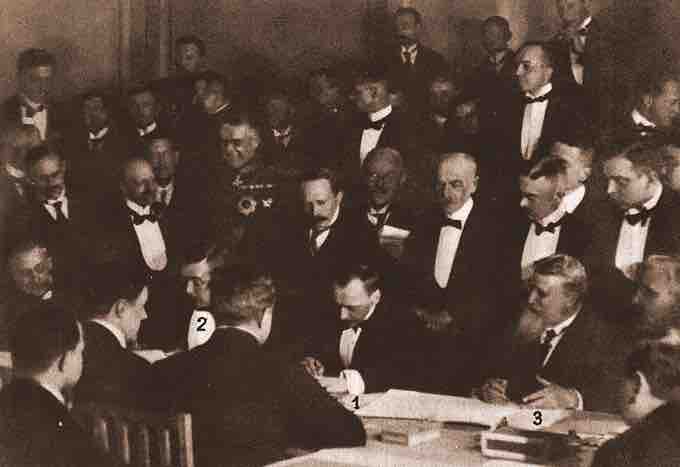The Central Powers alliance faced grim prospects in 1918. With a growing list of nations signing up with France and Britain, Germany and its imperial allies suffered mounting losses. What had in 1914 seemed to be an assured victory resulted in a crushing and humiliating defeat.
Beginning of the End
The four Central Powers of Germany, the Austro-Hungarian Empire, the Ottoman Empire, and Bulgaria faced the combined might of the Allied Powers of the United States, France, and the United Kingdom with its British imperial dominion nations of Australia, New Zealand, Canada, and South Africa. Belgium became a partner following its invasion by Germany at the beginning of the war, while several other nations took encouragement from America’s entry in April 1917 and joined the Allies, including Japan, Serbia, Montenegro, San Marino, Italy, Portugal, Romania, Cuba, Panama, Guatemala, Nicaragua, Honduras, Haiti, Costa Rica, Brazil, Liberia, Siam (Thailand), and China. Some of these nations did not provide troops, but instead contributed monetarily. The Germans launched a final, desperate attack on France that failed miserably, while the other Central Powers began to capitulate in the face of Allied counterattacks.
Central Powers Poster
A propaganda poster depicts the alliance between the Central Powers in World War I.
Central Powers Collapse
Bulgaria was the first to collapse when a combined force of French, British, Italians, Serbs, and Greeks attacked through Albania in September 1918. By the end of the month, Bulgaria surrendered and withdrew its troops from Serbia and Greece, even allowing the Allies to use Bulgaria in military operations.
During the 1916-1918 Arab Revolt in what is now the Middle East, the Ottoman Army fell to British forces and Arab nationalist fighters aided by a key British military liaison and guerilla leader named T. E. Lawrence, better known as Lawrence of Arabia. Approximately a month after Bulgaria's surrender, the Ottoman Empire surrendered and permitted Allied military forces to use Ottoman territory, including the strategically important Dardanelles Strait, which had been the site of fierce naval and ground fighting between Allied and Ottoman forces beginning in 1915.
T.E. Lawrence, photo by Lowell Thomas, 1918
T.E. Lawrence, better known as "Lawrence of Arabia," in Jerusalem upon being introduced at the office of the British military governor on February 28, 1918. The photo was taken by Lowell Thomas, an American war correspondent and broadcaster whose photos and film are credited with making Lawrence famous.
The Austro-Hungarian Empire also surrendered in October. The Habsburg royal family and the Austro-Hungarian government desperately sought to keep its domain of diverse nationalities together, but the once-powerful dynastic empire fell apart and split into the separate states of Austria, Hungary, Czechoslovakia, and Yugoslavia.
With no one to stand alongside it, Germany surrendered and on November 11, 1918, the horrors of World War I finally came to an end.
Terms and Fallout of Defeat
U.S. President Woodrow Wilson required that Germany accede to the terms of the Fourteen Points, which required the return of territory acquired by the Treaty of Brest-Litovsk to Russia, and the provinces of Alsace and Lorraine to France. Germany considered the terms extremely harsh, while the Allied nations found them too lenient. However, when Emperor Wilhelm II abdicated the throne, the new German government quickly agreed to Wilson's demands. The details of the agreement were hammered out the following year during the Paris Peace Conference.

Signing the Treaty of Brest-Litovsk
Signing the Treaty of Brest-Litovsk (February 9, 1918). Russia ceded territory to Germany in this treaty, which was reversed with the end of World War I.
By the end of the war there were millions of casualties. Many died in battle, while others succumbed to disease and malnutrition resulting from the destruction of their homes and surroundings. Additionally, somewhere between 20 and 40 million people – more than the number who died in the Great War itself – were overrun by an influenza pandemic known as “Spanish Flu” that spread throughout the world in 1918-1919. The economic toll was incredibly high as a result of the war, both in the overall shift in production concerns and the deprivation of nations denied or stripped of resources, causing widespread starvation throughout Europe during the winter of 1918-1919. Many veterans found themselves homeless and jobless upon their return from the battlefields.
World War I had touched every aspect of the lives of those who survived to see much of Europe and its territories in ruins.